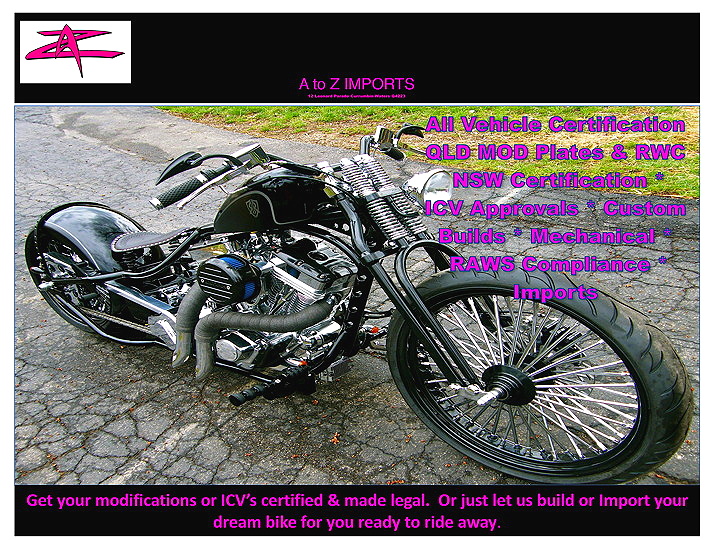
Convert Your Harley-Davidson Sportster to a Road Racer
Evy decided to upgrade her humble XL883 Iron with a 1200 cc Stage 2 Big Bore Kit and didn’t it kick arse.
MY 883 IRON is a seriously fun bike and it does everything I ask of it. Although it’s a ‘small’ Harley-Davidson, it’s still a big bike compared to most bikes on the road. If I was riding up the Old Pacific Highway from Sydney to Gosford, I wouldn’t be going any faster on a bigger bike. In fact, it’s so nimble, it quite often rounds up many bigger bikes through the twisties, especially Fat Boys which scrape their floorboards on every corner. Bring it on.
But it does run out of steam on the M1 Pacific Motorway. At 110 km/h, overtaking is slow, the 883 has to wind herself up to get past another vehicle travelling at the legal limit, whereas the bigger twins have almost instantaneous overtaking performance.
I had already put 10,000 km on the clock when I decided to look at the options for upgrading my humble 883 motor.
I wanted to use Genuine Screamin’ Eagle Harley parts, installed by a Harley dealer, because I know they are made by Harley for Harleys and everything is going to fit as they were designed to do. Checking out the Harley Catalogue, I found there were two possible upgrade kits: one took it to original XL1200 specs (as they say, there’s no substitute for cubic inches); the other to 1200 cc Stage 2 race specs. Since they were both about the same price, and the labour for the installation was similar, it seemed a no-brainer to go for the Stage 2 kit.
It’s worth noting that the 883 and 1200 motors are the same except for the top-end — the 883 even runs 1200 cams — so upgrading my 833 to 1200 cc is well within its design capabilities.
I arranged for Fraser Motorcycles in Concord to do the installation while my dad hung around taking photos.
The kit comes complete with all the gaskets, new cams, a Screamin’ Eagle Super Tuner (I already had one so Frasers gave me a credit on the new one), big bore cylinders and matching pistons designed to work with the original heads, and a heavy duty clutch spring.
The new pistons take the compression ratio from 9.0: 1 to 10.1: 1; a considerable increase.
Apparently different cams with different overlaps are necessary with higher compression pistons, and the SE Pro XL cams in the kit also take the lift from 0.480” to 0.551”; again, a considerable increase.



Elliot, the Harley technician, had obviously done this conversion before. The Sportster went up on the work bench, and before long the heads and barrels were off, the timing case opened, the old cams removed.
Putting it back together was another story. Everything (piston ring gaps, etc) had to be measured and checked, pre-oiled and torqued down correctly so it took considerable longer.
Once the Sportster was back together, it needed ECM re-calibration and she was ready for running-in.
For the sake of this article, I had had the bike up on the dyno at Frasers prior to the modifications, and now Elliot suggested I ride her for at least 800 km before we put her back on the dyno to measure the difference. No worries, I can do that in a couple of weeks.




My first impression wasn’t good. A high compression motor with high lift cams idles lumpy, doesn’t run smoothly at low speeds, and that’s exactly where I had to ride the Sporty for the first 100 km with the new pistons.
But as the miles clocked up and I was able to ride faster, it became more than obvious that this Sportster was now a rocket ship. I had to learn to ride it differently, ride it more aggressivelyv—vas the revs came up from idle, she smoothed out quicklyv—vand didn’t it kick arse at those higher revs!
I did, however, make an expensive mistake. I had asked Elliot not to install the heavy duty clutch spring; I was worried it would increase the clutch lever effort too much for me. I figured the 883 clutch could handle the extra power. Wrong! Within a week I had burnt out the poor old 883 clutch — and that’s while I was running it in! It cost me $600 to replace the clutch plates, and of course, I had them put the heavy duty clutch spring in at the same time. As it turned out, the stronger spring didn’t increase the clutch lever effort all that much.
Burning out the clutch is probably the best way to describe how much more power this Sportster has. When it used to run out of puff at 110 km/h on the M1 Pacific Motorway, it’s now just coming on strong. It has so much power at that speed it’s frightening; there’s no way I can hold the throttle full-on in top gear — the speedo just keeps climbing and climbing. Way too easy to loose your licence with this upgrade. Overtaking? It happens so quickly it makes your eyes water.
A couple of weeks later I turned up at Fraser Motorcycles to do another dyno run. The increases are pretty amazing: max power up from 53.05 to 72.42 hp. That’s a 36.5 percent increase. Max torque up from 49.42 to 70.6 ft/lb. That’s a staggering 42.86 percent increase. No wonder I burnt the poor old 883 clutch out.

Now here’s the rub: assuming you already have a high flow air filter, performance exhaust and an EFI tuner, you can build a 1200 cc Stage 2 Sportster from an 883 Iron for nearly $1000 less than buying a stock XL1200 cc Sportster. Go figure.
article by Evy Wiggins
Discover more from Ozbike Digital Magazine
Subscribe to get the latest posts sent to your email.


great article…. im in